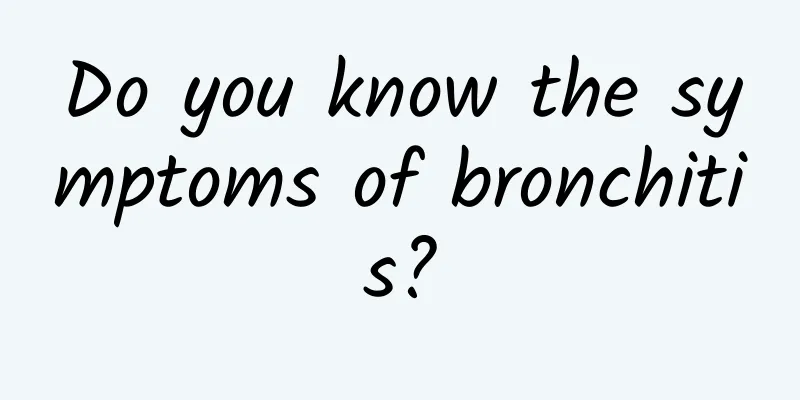Do you know the symptoms of bronchitis?

|
In recent years, with the unstable weather changes, more and more people have suffered from bronchitis. This disease is divided into acute bronchitis, and patients will experience symptoms of upper respiratory tract infection such as nasal congestion, sneezing, sore throat, hoarseness, etc.; chronic bronchitis will manifest as chronic cough, sputum, and wheezing. 1. Symptoms of acute bronchitis: The main initial symptoms are upper respiratory tract infection symptoms such as nasal congestion, sneezing, sore throat, hoarseness, etc., followed by coughing and sputum. At first it is an irritating dry cough or a small amount of mucous sputum, which later turns into mucopurulent sputum. Systemic symptoms may include chills, fever, headache, sore limbs, etc. The symptoms are relatively mild. Asthma may occur if accompanied by bronchospasm. (1) There is often a history of catching cold, excessive fatigue or other triggering factors. (2) Clinical manifestations include cough, sputum accompanied by chills, fever, headache, and limb pain. (3) The breath sounds in both lungs become coarser, with scattered dry and wet rales. (4) The white blood cell count is usually normal, and X-ray examination of the lungs usually shows normal or coarsened lung texture. Clinically, it is characterized by long-term persistent cough. Coughing occurs frequently in the morning and evening when the temperature is low or when food is irritating. When there are no complications, there are no changes in body temperature or pulse. There is no change in breathing at the beginning of the disease. Later, due to the hyperplasia and thickening of the connective tissue of the bronchial mucosa and the narrowing of the bronchial lumen, breathing difficulties occur. When complicated by emphysema, breathing is extremely difficult. This difficulty in breathing is characterized by respiratory or mixed dyspnea, with intercostal retractions and the appearance of intercostal grooves. Auscultation of the chest reveals increased alveolar sounds, which weaken when complicated by emphysema, and dry rales can often be heard. The chest percussion sound is high-pitched and the lung borders are enlarged. X-ray examination showed that the bronchial shadows in the lungs became heavier and longer. 2. Clinical manifestations of chronic bronchitis: Symptoms usually develop slowly, last for a long time, and are aggravated by repeated acute attacks. The main symptoms are chronic cough, sputum and wheezing. Symptoms may be mild at first, but may worsen or become acute after smoking, exposure to harmful gases, overwork, climate change, or a cold. Or an upper respiratory tract infection may linger and develop into chronic bronchitis. When the weather warms up in the summer, the symptoms will usually be relieved naturally. (1) Cough: Bronchial mucosal congestion, edema or accumulation of secretions in the bronchial cavity can cause cough. The severity of the cough depends on the condition. Generally, the cough is more severe in the morning and lighter during the day. There are bouts of coughing or sputum discharge before going to bed at night. (2) Coughing up phlegm: Due to the accumulation of phlegm in the bronchial lumen after sleep at night, the parasympathetic nerves are relatively excited, and the bronchial secretions increase. Therefore, getting up or changing body position causes irritation and expectoration. The sputum is usually more in the early morning. The sputum is generally white mucus or serous foam, and may occasionally contain blood. Severe and repeated hemoptysis may indicate a serious lung disease, such as a tumor. When an acute attack is accompanied by acute infection, it becomes mucopurulent, and the cough and sputum volume also increase. (3) Wheezing or shortness of breath: Asthmatic chronic bronchitis causes bronchospasm, which can cause wheezing, often accompanied by wheezing rales. There is no shortness of breath in the early stage. Recurrent attacks for several years, when complicated by obstructive pulmonary emphysema, may be accompanied by shortness of breath of varying degrees. The patient may first have shortness of breath after labor or activity. In severe cases, the shortness of breath becomes more severe with movement, making it difficult for the patient to take care of himself. In short, cough, sputum and wheezing are the main symptoms of chronic bronchitis, and the clinical manifestations may vary depending on the type, stage of the disease and the presence or absence of complications. |
<<: What are the traditional Chinese medicines for treating rhinitis?
>>: What fruits are good for pharyngitis?
Recommend
If this thing grows on your nose, be careful that you won't live long.
Traditional Chinese medicine believes that the sp...
What to do if you get pregnant after taking Chinese medicine to regulate menstruation
Menstruation is a sign of a girl’s growth. Not on...
Is pericarditis serious?
Pericarditis is a relatively serious disease. It ...
Prevention and treatment of anxiety disorders
Anxiety disorder is also called anxiety neurosis....
What are the symptoms of gynecological trichomoniasis
Trichomoniasis in women is a common gynecological...
A dry and bitter mouth is so torturous, what is going on?
There is a bitter taste in the mouth, and even wa...
What causes nipple pain?
In today's society, many women will experienc...
How to treat people with weak body
Physical weakness and coldness are also relativel...
Causes of acne under the right cheek
Generally speaking, acne is caused by excessive o...
Can moxibustion be used to treat fractures?
Fractures require different treatments and method...
Early symptoms of hemorrhoids
Hemorrhoids are very common in life. As the sayin...
The role of Acanthopanax bark
The medicine Acanthopanax bark is used to make wi...
Can I eat fish after a caesarean section?
Caesarean section is a way of delivery for women ...
How to reduce the nose wings more effectively?
Many people have relatively large nose wings, whi...
What are the benefits of moxibustion at Yongquan?
Moxibustion has a long history in traditional Chi...









